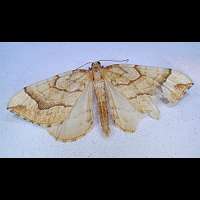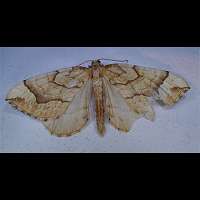Spinach (Eulithis mellinata)
The basic colour of the wings of the Spinach is creamy white to ochre. Over the wings run a few rusty lines. This makes you wonder why it is called the Spinach. Even though it is not a very striking species when it comes to colours, its resting pose sets it apart from all other Geometers. The wings are hold horizontally and the edges of the hindwings are slightly lifted up, while the last part of the body is curled upwards. A resting pose not unheard of in the world of the Snout Moths, but unique in Geometers. The Spinach shares this characteristic with the very similar Barred Straw. And as both species are the same size (the wingspan is 33 to 38 mm), they are real look-a-likes. Still they can be told apart quite easily by looking at the fringes of the wings, which are chequered in the Spinach and not in the Barred Straw.
The eggs are laid in summer on twigs of the foodplant. They don't hatch before March or April next year, meaning it is the egg overwintering. The caterpillars grow very fast. They feed by night and may be found resting on the underside of a leaf during the day. By the end of May they are ready to pupate. They spin together a few leaves and make a cocoon inside. These leaves may be fresh leaves, meaning the cocoon hangs in the foodplant. Some larvae however prefer to pupate among the leaf debris on the ground. In June the first moths appear. The larvae are greenish. There may be some yellow accents near the end or beginning of a body segment. The head is green. Despite the name the larvae are found on Red Currants and Black Currants exclusively. This makes you wonder about the name of this species for a second time, doesn't it?
The Spinach is on the wing from June to mid-August. Starts flying at dusk and comes to light freely. This is a typical garden species, due to the foodplants of the caterpillars. Because less and less people tend to cultivate the host plants, this moth shows declining numbers. Not uncommon in England and Wales, a rather local species in Scotland and the Hebrides and very rare in Ireland, where it is only found around Dublin. This is a lowland species only, not to be found in mountainous areas. A fairly common species on the continent as well.
The basic colour of the wings of the Spinach is creamy white to ochre. Over the wings run a few rusty lines. This makes you wonder why it is called the Spinach. Even though it is not a very striking species when it comes to colours, its resting pose sets it apart from all other Geometers. The wings are hold horizontally and the edges of the hindwings are slightly lifted up, while the last part of the body is curled upwards. A resting pose not unheard of in the world of the Snout Moths, but unique in Geometers. The Spinach shares this characteristic with the very similar Barred Straw. And as both species are the same size (the wingspan is 33 to 38 mm), they are real look-a-likes. Still they can be told apart quite easily by looking at the fringes of the wings, which are chequered in the Spinach and not in the Barred Straw.
The eggs are laid in summer on twigs of the foodplant. They don't hatch before March or April next year, meaning it is the egg overwintering. The caterpillars grow very fast. They feed by night and may be found resting on the underside of a leaf during the day. By the end of May they are ready to pupate. They spin together a few leaves and make a cocoon inside. These leaves may be fresh leaves, meaning the cocoon hangs in the foodplant. Some larvae however prefer to pupate among the leaf debris on the ground. In June the first moths appear. The larvae are greenish. There may be some yellow accents near the end or beginning of a body segment. The head is green. Despite the name the larvae are found on Red Currants and Black Currants exclusively. This makes you wonder about the name of this species for a second time, doesn't it?
The Spinach is on the wing from June to mid-August. Starts flying at dusk and comes to light freely. This is a typical garden species, due to the foodplants of the caterpillars. Because less and less people tend to cultivate the host plants, this moth shows declining numbers. Not uncommon in England and Wales, a rather local species in Scotland and the Hebrides and very rare in Ireland, where it is only found around Dublin. This is a lowland species only, not to be found in mountainous areas. A fairly common species on the continent as well.





